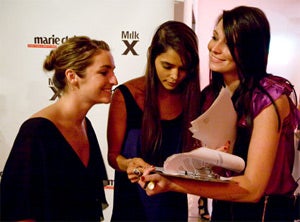Last Night's Television - Running in Heels, E4; Tweed, BBC4
Dark side of the loom

Watching Tweed you can’t help but fear that you’re looking at a dying artisanal craft, a proud tradition of craftsmanship and culture that will find it hard to survive in an increasingly mercantile world.
Once, there were lots of documentaries like this, made the slow way and stubbornly indifferent to passing fashion. But how long can such a cottage industry sustain itself against mass-produced reality shows and polyester formats? You can almost imagine a wide-eyed enthusiast, in 50 years’ time, being told about the unimaginable heyday of public broadcasting.“ They really made a whole series about one type of handmade cloth?” “Yes.” “And they really called it Tweed? Not something like ‘Weaving a Rainbow’ or ‘The Stuff of Life’ or ‘Local Heroes?’” “Yes... they just called it Tweed. They were plain, proud men back then, impatient of frivolity.”
For myself, the fact that the BBC would commission and broadcast a series like this – and stick it in the Radio Times with that take-it-or-leave-it title – is an argument for the licence fee in itself. But above and beyond the cherishable thud of its title, Tweed turns out to be rather good, an account of a dying industry twitching so fitfully on its deathbed that it may yet kick itself back into life. Its first episode, last week, concentrated on Brian Haggas, a Yorkshire textile man who’d decided to rescue Harris Tweed as a kind of retirement project. Brian bought the Stornoway mill that supplies most of the individual weavers with their yarn and announced that good times were just around the corner. Unfortunately, the weavers soon discovered that his strategy was that of the Vietnam general who explained that in order to save the village it had been necessary to destroy it.
Brian rationalised the pattern range from around 8,000 to just four, perversely choosing shades that might have been calculated to illustrate the pejorative sense of the word “tweedy” as a synonym for boring. He then cut off supplies of yarn to anyone wanting to make more interesting fabric, in an attempt to corner the world market in Harris Tweed jackets. Sadly for Brian, the world wasn’t interested, despite a feverish sales push. So this week, with thousands of unsold jackets in his warehouse and countless bolts of unsaleable tweed on his books, he was back in Stornoway laying off his workers and mothballing his freshly painted mill.
The upside to this sorry tale being the fact that other tweed enthusiasts have finally been galvanised into action by the Haggas threat – and have descended on the isle of Lewis to introduce its somewhat startled inhabitants to the manners of American entrepreneurs and London fashionistas. There was a delicious sequence in which a foppish toff called Guy Hills – a tweed obsessive who dresses in Bertie Woosterish plusfours – found himself face to face with the bemused mill worker in overalls, and the invasion isn’t over, since another tweed revivalist has taken on Deryck Walker, a trendy young Scottish menswear designer, to haul the fabric into the 21st century.
The culture shock was considerable, but frankly they were in desperate need of outside help since the Harris Tweed Authority appeared to be pinning its hopes of an industrial revival on some of the ugliest novelty gonks ever produced – objects that could induce nightmares in the more sensitive child. Happily, the films themselves are a very potent advert for the fabric, which manages to conceal beneath its sturdy and unflashy surface intense twists of colour and a genuine connection to the landscape in which it is made.
You could say much the same for Malcolm Neaum and Ian Denyer’s surprisingly engrossing series. Not a lot of tweed in Running in Heels, where the themes of the week were shift dresses and jumpsuits. A reality elimination version of The Devil Wears Prada, which challenges three clueless clotheshorses to win a job on American MarieClaire, E4’s show is about as challenging intellectually as the average make-up feature. Talita is the bitch queen, schmoozing other people into doing her work for her before sloping off early to iron her hair. Ashley is the dippy one, who spends most of her time handcrafting excuses for her failure to perform the tasks they’ve been set (“I had a kind of weird karma moment... I gave my last dollar to a homeless man and then realised that was my dollar for the subway”) and Samantha is the school swot, beavering away like crazy but getting all teary when she realises that she can’t fit into the micro-sized sample garments. We like Samantha, who at least seems to grasp the concept that hard work is the currency of success rather than sulky pouting or Carrie Bradshaw-style ditziness, but sadly she fared no better than the others when they all presented their work to the British editor Joanna Coles, who appears to be taking part in an unannounced competition to become the next Anna Wintour.
Subscribe to Independent Premium to bookmark this article
Want to bookmark your favourite articles and stories to read or reference later? Start your Independent Premium subscription today.

Join our commenting forum
Join thought-provoking conversations, follow other Independent readers and see their replies